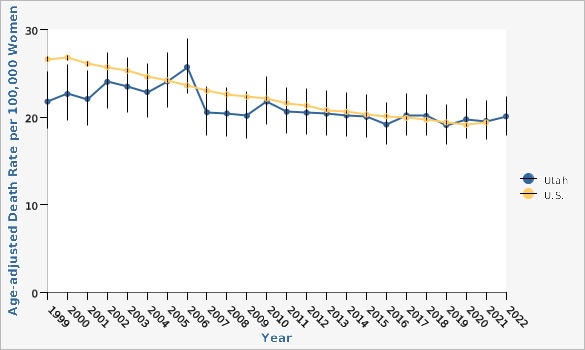Why Is This Important?
Breast cancer is the most commonly occurring cancer in U.S. women (excluding skin cancers) and a leading cause of female cancer deaths in both Utah and the U.S. Nationally, deaths from lung cancer surpass deaths from breast cancer; however, breast cancer is the leading cause of cancer death among Utah women. Deaths from breast cancer can be substantially reduced if the tumor is discovered at an early stage. Mammography is currently the best method for detecting cancer early. Clinical trials and observational studies have demonstrated that routine screening with mammography can reduce breast cancer mortality by about 20% for women of average risk.^1^
Certain risk factors are linked to the development of breast cancer such as increased age, smoking, obesity, dense breast tissue, lower socioeconomic status, exposure to ionizing radiation, family history of breast cancer, BRCA 1 or BRCA 2 gene mutations, alcohol consumption, and hormonal influence over time. Some studies indicate that environmental contaminants such as benzene and organic solvents can also cause mammary tumors, but clear links have not been established.[[br]]
[[br]]
----
''1. Myers ER, Moorman P, Gierisch JM, et al. Benefits and harms of breast cancer screening. JAMA. doi:10.1001/jama.2015.13183.''Breast Cancer Deaths by Year, Utah and U.S., 1999-2022 |
Data Sources
- Utah Death Certificate Database, Office of Vital Records and Statistics, Utah Department of Health and Human Services
- For years 2020 and later, the population estimates are provided by the Kem C. Gardner Policy Institute, Utah state and county annual population estimates are by single year of age and sex, IBIS Version 2022
- Population Estimates for 2000-2019: National Center for Health Statistics (NCHS) through a collaborative agreement with the U.S. Census Bureau, IBIS Version 2020
- U.S. Underlying Cause of Death Data: WONDER Online Database. Centers for Disease Control and Prevention, National Center for Health Statistics. Accessed at [http://wonder.cdc.gov/ucd-icd10.html]
Data Notes
Codes used to define female breast cancer: ICD-10 C50. ^ ^[[br]]
Age-adjusted to U.S. 2000 standard population.Risk Factors
The most important risk factor for breast cancer is increasing age. Other established risk factors include personal or family history of breast cancer, history of abnormal breast biopsy, genetic alterations, early age at onset of menses, late age at onset of menopause, never having children or having a first live birth at age 30 or older, and history of exposure to high dose radiation. Associations have also been suggested between breast cancer and oral contraceptives, long-term use of hormone replacement therapy, obesity and physical inactivity (in post-menopausal women), alcohol, and a diet high in fat. Some studies suggest that exercise in youth might give life-long protection against breast cancer and that even moderate physical activity as an adult could lower breast cancer risk. More research is needed to confirm these findings.How Are We Doing?
The female breast cancer mortality rate in Utah has decreased slightly over time, from 21.8 deaths per 100,000 females in 1999 to 20.1 deaths per 100,000 females in 2022. Although the overall mortality rate has declined over the past two decades, trends in breast cancer mortality vary by different sociodemographic characteristics, including age, geography, and race/ethnicity.
Examining trends in breast cancer mortality by different age groups reveals that the risk of breast cancer death increases significantly with age. For combined years 2018-2022 there were 203.2 deaths due to breast cancer per 100,000 women aged 85 years or older, the highest rate among all age groups. In comparison for the same time period, there were 38.8 deaths per 100,000 women aged 55-64, 60.5 deaths per 100,000 women aged 65-74, and 106.5 deaths per 100,000 women aged 75-84 attributed to breast cancer.
There are also differences in breast cancer mortality rates distributed geographically. From 2018 to 2022, Southeast Utah Local Health District had the highest breast cancer mortality rate of 23.2 deaths per 100,000 women, while Central Utah had the lowest rate with 16.0 deaths per 100,000 women (age-adjusted rates). Geographical distribution of breast cancer deaths can also be viewed in more detail at the Utah Small Area level (see additional data views).
Differences in breast cancer death rates are also apparent for different racial and ethnic groups in Utah. For combined years 2018-2022, Hispanic women had a lower age-adjusted breast cancer mortality rate (15.5 deaths per 100,000 women) than non-Hispanic women (19.8 deaths per 100,000 women), though this was not a statistically significant difference. When looking at breast cancer mortality rates by race for the same time period, Asian women had significantly lower breast cancer death rates (7.5 deaths per 100,000 women) than all races combined (19.6 deaths per 100,000 women), while Native Hawaiian/Other Pacific Islander women had the highest breast cancer death rates (32.7 deaths per 100,000 women).What Is Being Done?
The Utah Breast & Cervical Cancer Program (Utah B&C) partners with local health departments, community clinics, hospitals and healthcare professionals to help those with low incomes who do not have adequate insurance gain access to timely breast and cervical cancer screening, diagnostic and treatment services. Eligible women can apply to Utah B&C by calling 800-717-1811 or by submitting an online enrollment form available at: [https://cancerutah.org/do-i-qualify/].
The Utah Cancer Coalition a statewide partnership whose goal is to reduce the burden of cancer. The coalition works to lower cancer incidence and mortality in Utah through collaborative efforts directed toward cancer prevention and control. As a result of this planning process, objectives and strategies have been developed by community partners regarding the early detection of cervical, testicular, prostate, skin, breast, and colorectal cancers as well as the promotion of physical activity, healthy eating habits, and smoking cessation.
Date Indicator Content Last Updated: 03/26/2024
Other Views
- by Year, Utah and U.S., 1999-2022
- by Age Group, Utah, 2018-2022
- by Local Health District, Utah, 2018-2022
- by Utah Small Area, 2018-2022
- by Ethnicity, Utah, 2018-2022
- by Race, Utah, 2018-2022

